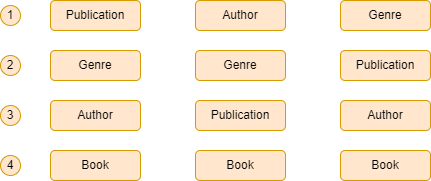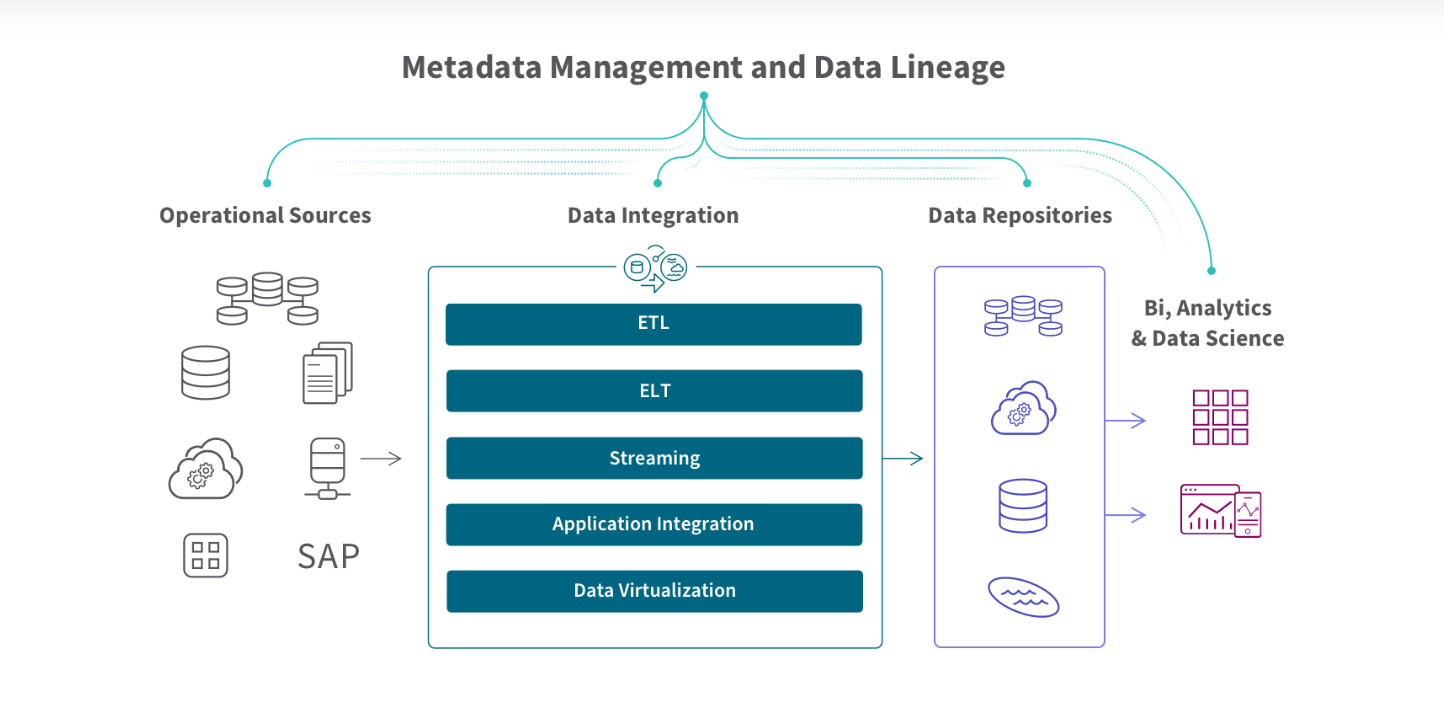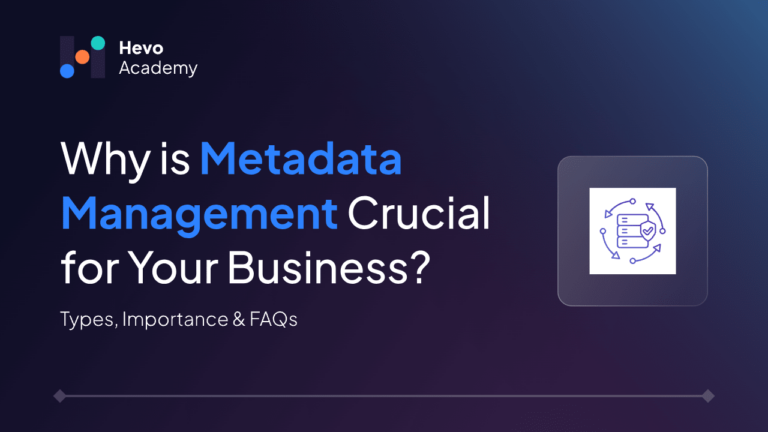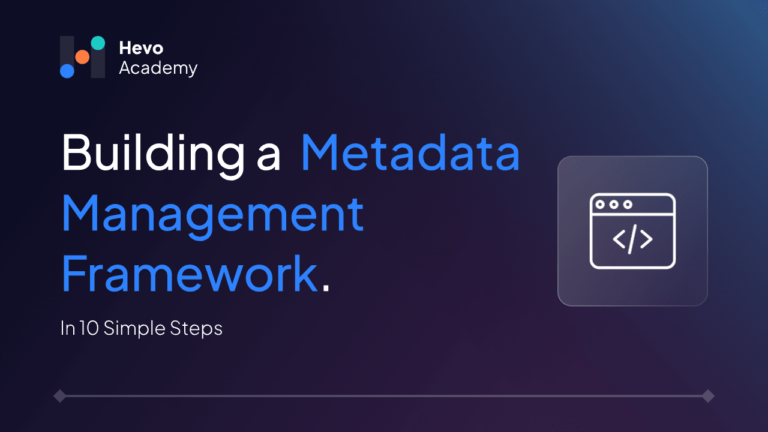An Anatomy of Work report reveals managers spend 62% of their time on “work about work,” such as communication, chasing updates, and searching for data. 58% of employees cite finding documents as a major time-waster, consuming 3.6 hours daily. This constant search for information leads to burnout, affecting productivity and retention. This blog intends to educate users about metadata, its importance, metadata management, why we need it, and the best practices for implementing it.
Table of Contents
Hevo is the only reliable and cost-effective ETL solution that lets you migrate data from 150+ sources to a destination of your choice. With Hevo Data, you get:
- Effortless ELT: Load and format data directly in Hevo’s pipelines.
- Flexible data replication: Sync entire databases or specific tables.
- Multi-region support: Seamlessly manage data across regions.
Join 2000+ customers who swear by Hevo’s seamless data integration and chose it over Fivetran and Stitch.
Get Started with Hevo for FreeWhat is Metadata?
The simplest definition of metadata is that it is the data about data. We can talk about metadata in two different ways. The first is a very technical and traditional view of metadata. It explains how long the field is and whether it can be blank on the database. It also tells us how and where the data is stored and in what table and column in your database. However, business users might not be interested in this kind of metadata.
The second view is the business metadata, which is much more interesting to business users or those doing data governance. This kind of metadata gives information about what the data is used for, what system it is stored on, who the data owner is, and who the data steward is. So, metadata is extremely valuable, and metadata management is critical to data governance.
There are three types of metadata:
1. Descriptive metadata: This gives the descriptive attributes of an entity. We will take an example of the descriptive metadata for a book. In the figure below, the descriptive metadata describes the details of the book ‘The Origin’.

2. Structural metadata: This is the information describing the structure of the data. If we look at the figure below, we will see that the data is organized based on different structures for every book. When you store the data in a system, every level will be stored as a table. So, you will have a Publication, Genre, Author, and a Book table.

3. Administrative metadata: This data is about the access permissions, data lineage, and license. For example, if you have a particular data asset coming into the system or your organization, there will be a date when the data was created and there might be an expiry date for the data as well, like in the case of licenses. This kind of data is classified under administrative metadata. Access privileges also fall under the administrative metadata.
Why is Metadata Important for Businesses?
Businesses need to track and manage the system data. The systems or the business applications generate lots of data including log files, usage, and machine data. Here are some of the reasons why metadata is important for businesses:
- Metadata helps categorize and organize the data, making it easier to locate and retrieve.
- It leads to more reliable business insights and better decision-making.
- It helps track data lifecycles and enhances security by monitoring user access and changes.
- Metadata, through meta tags and descriptions, improves a website’s SEO (Search Engine Optimization) performance by providing search engines with relevant information.
- Metadata adds context to data for accurate analysis and helps businesses identify opportunities and drive innovation.
- It aids disaster recovery by providing a detailed data snapshot, speeding up recovery, and minimizing data loss.
There are a lot of business use cases of metadata using SaaS applications:
- Financial planning and forecasting
- Identity management service
- Data warehousing service
- Feature flagging
- Domain service for a customer call center
What is Metadata Management?
Organizations move millions of records daily into different systems and data warehouses. Organizations need to know where this data is going. For example, if you’re looking at a report and the graph shows a new division that does not exist. So, you ask yourself, “Where did this data come from?” This can be a messy situation for many organizations because the analysis process might cost a lot. This is where Metadata Management comes into the picture.
Each system in which the data is stored keeps a log of the data being handled. These logs are nothing but the metadata. By tying together the different metadata sources, you can get a picture of where the data is moving and how it is changing. Some leading vendors in data integration provide connectors to the metadata stored in ETL tools, BI tools, databases, data modeling tools, and other systems. Your ETL tool drives the entire data movement process. Metadata management helps you get a complete data tracking map. Metadata management tools also offer Business Glossary. It is an interface that enables business users to create descriptions for the data.
Data lineage is the process of tracking data flow through an organization’s systems. It shows the source of the data, how it is transformed, and where it is stored. The figure below outlines the data integration process:
- The data comes from various operational sources like databases, file systems, and systems like SAP.
- Data Integration: The data is processed through methods like:
- ETL/ELT (Extract, Transform, Load)
- Streaming (real-time data processing)
- Application Integration (connecting software systems)
- Data Virtualization (accessing data without physically moving it)
- Data Repositories: Processed data is stored in data lakes, warehouses, or marts for easy access.
- BI, Analytics, and Data Science: The stored data is used for business reporting, advanced analytics, and data science tasks.

Why do Organizations want to Document and Manage their Metadata?
We live in a data-centric world. Metadata functions as a catalog for data, helping users efficiently locate and retrieve it across systems. It describes the content, format, and structure of the data. It gives information about the data type, size, creation date, and source to guide users in determining if the data is relevant. It also manages permissions, ensuring the right users have access while restricting unauthorized access. Metadata enables data discoverability, helps provide information on the quality and reliability of the dataset, and enables data stored in different systems and databases to be interoperable, providing an up-to-date record of information.
Every organization has specific goals and objectives. The value of metadata lies in how it aligns with them. Managing the metadata ensures documents are accessible and ready for relevant stakeholders to view and manage, helps with information sharing and collaboration, and improves workflow.
Challenges in Metadata Management
The growing amount of data generated in multiple formats makes managing metadata increasingly tricky. As datasets expand, the cataloging and organizing metadata process becomes more complicated. Additionally, the variety of data types—structured, semi-structured, and unstructured—introduces further challenges, as each type requires a unique approach to metadata management.
Below are some of the challenges that organizations encounter when managing metadata:
- Disparate Information Sources: Maintaining a consistent and unified metadata catalog becomes difficult when data is spread across multiple systems in an organization. Integrating metadata from diverse sources can lead to discrepancies and inefficiencies in data usage.
- Enforcing Business Rules for Metadata: Ensuring that metadata adheres to specific business rules is a complex task. Different departments may follow varied rules, leading to inconsistency. Standardizing metadata practices across the organization is critical but challenging due to varied processes and technologies.
- Data quality and accuracy: Metadata can quickly become outdated, inaccurate, or incomplete, which might affect the quality of the underlying data. Poor metadata management can make the decision-making processes unreliable.
- Data Governance: Establishing strong governance frameworks around metadata is essential to maintain data privacy, security, and compliance with regulations. Without clear governance, metadata can become mismanaged, leading to gaps in compliance and data breaches.
Solutions and Strategies to Overcome These Challenges
- Utilize ML (Machine Learning): The process of defining metadata for datasets was traditionally hierarchical, using statistical algorithms to operate at the attribute, cross-column, or even cross-dataset level, often called data profiling. However, this method struggles to scale with increasing datasets and lacks flexibility. According to Gartner, organizations should instead use machine learning algorithms to analyze and better understand raw data, making this the first step in identifying the insights data can provide.
- Implement centralized metadata repositories to consolidate metadata from disparate sources, to ensure consistency and easier management across systems.
- Promote cross-departmental collaboration to ensure metadata management efforts align with the organization’s overall data governance policies.
- Implement data quality tools to check and validate metadata accuracy regularly.
Best Practices to Implement Metadata Management
Here are some guidelines and best practices for implementing Metadata Management:
- To build an effective metadata management strategy, setting clear goals and KPIs that align with your organization’s vision is essential. These objectives should be realistic, such as implementing scalable solutions, improving data democratization, and boosting productivity. Ensure that your KPIs are relevant, like tracking the impact of metadata-related policies on productivity.
- Metadata management is an ongoing, organization-wide process that requires a dedicated team. This team will work with the stakeholders to develop strategies and policies, ensure that workflows align with everyone’s needs, and fully leverage the power of data.
- The Dublin Core Metadata Element Set (DCMES) is a widely used schema for describing data resources. It consists of fifteen core elements, such as title, subject, and creator. Recognized as ISO 158369 in 2017, it enables the standardization and compatibility of metadata across various data sources, including audio, video, and text, ensuring that all stakeholders understand how to interact with the metadata effectively.
- Modern organizations need advanced metadata management tools that offer self-service data discovery, autoscaling for growing data needs, visual query builders for easy metadata extraction, and seamless integration with platforms like Tableau and SQL. These tools handle complex data environments by supporting active and passive metadata management.
Conclusion
Effective metadata management is critical for modern organizations to ensure data usability, accessibility, and governance. Key challenges include handling disparate data sources, ensuring data quality, and enforcing governance standards. Solutions like centralized metadata repositories, automation, and AI/ML tools help overcome these issues.
With seamless integrations, Hevo allows for in-depth analysis and better organization. It can assist in migrating your metadata to databases or data warehouses. This ensures efficient management and utilization of your metadata. Incorporating advanced metadata management tools like Hevo can transform how organizations manage, analyze, and leverage their data.
Schedule a personalized demo with Hevo for seamless data integration.
FAQ
1. Why is metadata management important for organizations?
Metadata management ensures that data is accessible, usable, and well-governed. It improves data discovery, enhances collaboration, and helps maintain data quality.
2. What are the common challenges in managing metadata?
Some key challenges include handling disparate data sources, maintaining data quality, enforcing business rules, and ensuring proper governance. These issues can complicate metadata organization and lead to inefficiencies.
3. How can Hevo assist in migrating metadata for better analysis?
Hevo simplifies metadata migration to databases or data warehouses, enabling more thorough analysis and better metadata organization, ultimately improving data management workflows.
4. How can organizations overcome metadata management challenges?
Implementing centralized metadata repositories, automating metadata updates, enforcing governance standards, and leveraging AI/ML tools can help organizations effectively manage metadata across diverse systems.






